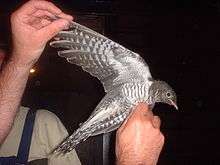Cuculus
Cuculus is a genus of cuckoos which has representatives in most of the Old World, although the greatest diversity is in tropical southern and southeastern Asia. The genus name is from Latin Cuculus, "cuckoo"[1] [2]
| Cuculus | |
|---|---|
 | |
| Male common cuckoo (Cuculus canorus) | |
| Scientific classification | |
| Kingdom: | Animalia |
| Phylum: | Chordata |
| Class: | Aves |
| Order: | Cuculiformes |
| Family: | Cuculidae |
| Genus: | Cuculus Linnaeus, 1758 |
| Species | |
|
11, see text | |
The species in taxonomic order are:
- Sulawesi cuckoo or Sulawesi hawk-cuckoo, Cuculus crassirostris
- Red-chested cuckoo, Cuculus solitarius
- Black cuckoo, Cuculus clamosus
- Indian cuckoo, Cuculus micropterus
- Common cuckoo, Cuculus canorus
- African cuckoo, Cuculus gularis
- Himalayan cuckoo, Cuculus saturatus
- Oriental cuckoo, Cuculus optatus (formerly horsfieldi')
- Sunda cuckoo, Cuculus lepidus
- Lesser cuckoo, Cuculus poliocephalus
- Madagascar cuckoo, Cuculus rochii
Some sources also include the pallid cuckoo in this genus, although there is disagreement about appropriate classification.[3]
The hawk-cuckoos are now placed in a separate genus, Hierococcyx, while the pallid cuckoo belongs in Cacomantis.
These birds are of variable size with slender bodies, long tails and strong legs. Most occur in open forests, but some prefer more open country. Several species are migratory.
These are vocal species, with persistent and loud calls. They feed on large insects, with hairy caterpillars, which are distasteful to many birds, being a speciality. One or two species will also take some fruit.
Cuculus cuckoos are brood parasites, that is, they lay a single egg in the nests of various passerine hosts. The best-known example is the European common cuckoo. The female cuckoo in each case replaces one of the host's eggs with one of her own. The cuckoo egg hatches earlier than the host's, and the chick grows faster; in most cases the cuckoo chick evicts the eggs or young of the host species.
Cuculus species lay coloured eggs to match those of their passerine hosts. Female cuckoos specialise in a particular host species (generally the species that raised them) and lay eggs that closely resemble the eggs of that host.
A species may consist of several gentes, with each gens specialising in a particular host. There is some evidence that the gentes are genetically different from one another though other authorities state that as female cuckoos mate with males of any gens, genes flow between gentes.
References
- Jobling, James A (2010). The Helm Dictionary of Scientific Bird Names. London: Christopher Helm. p. 124. ISBN 978-1-4081-2501-4.
- "Cuckoo". Oxford English Dictionary (3rd ed.). Oxford University Press. September 2005. (Subscription or UK public library membership required.)
- Payne, RB (2005). The Cuckoos. Oxford University Press. 423.
Further reading
- Brooke, Michael deL.; Horsfall, John A. (2003). "Cuckoos". In Christopher Perrins (ed.). Firefly Encyclopedia of Birds. Firefly Books. pp. 312–315. ISBN 1-55297-777-3.